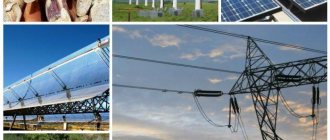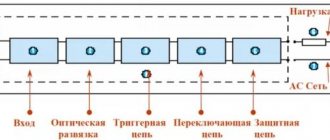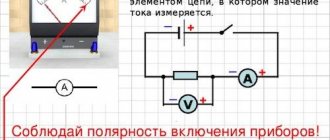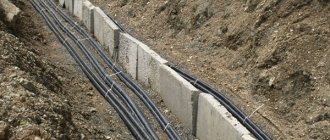Types of wind energy
The growth of energy consumption is accelerating every year.
The emergence of new devices, household appliances, and computer equipment increases the needs of the population and forces an increase in the capacity of centralized lines. Their condition, already quite dilapidated, becomes even more deplorable under such loads. The deterioration of power grids in some regions reaches 70-80%, which makes us think about the future. On the other hand, there are many regions where power lines have not yet been installed. These are remote areas of the Far North, hard-to-reach mountain settlements, etc. There is no hope for rapid electrification of such places, since there are no important industrial or defense facilities there, and building a line “to nowhere” is irrational; it will never pay off.
A way out of this situation may be to use alternative methods of generating electricity. Let's consider one of the most promising options.
Air flow
In fact, wind energy - kinetic. The air flow has enormous power, the effect of which can be observed in videos or photographs of the consequences of hurricanes or simply gusts. There are much more devices that in one way or another use wind energy to perform some kind of work, produce electric current and other needs. Thus, pumps powered by a windmill have been known since time immemorial, and modern wind power plants provide electrical energy to entire countries and regions.
A special feature of wind energy is its availability . To create a hydroelectric power station, it is necessary to find a section of the river bed suitable for the topography and build a dam that will flood a large area of the usable surface of the earth. Arable lands are suffering and disappearing, the natural habitat of animals is being disrupted, and the climate in the region is changing.
For nuclear energy, it is necessary to obtain nuclear fuel, build a nuclear power plant, and throughout its operation there is a tangible risk of an accident that threatens a major catastrophe. Using wind is practically safe and has no negative impact on nature or humans.
Opponents of wind energy declare various problems created by the use of wind farms, but they have never provided facts confirming these problems. Practice refutes all speculation regarding the harm from wind farms, confirming only the beneficial properties.
The "oldest" source of energy
Wind is the forward movement of air masses in a horizontal direction. The reason for the appearance of wind on our planet is the uneven heating of the air in its different parts. Thus, equatorial air masses heat up more than air in the tropics, in the temperate and polar climate zones. Since wind is associated with the movement of a gaseous substance, it represents mechanical energy.
How does a person use the wind? It should be said that this energy has been used since time immemorial. An example can be given of windmills that ground grain or pumped out large volumes of water. According to historical archives, the first windmills were constructed in Persia in the 7th century AD. It is interesting to note that the blades of these inventions, unlike modern analogues, were located horizontally. From Persia the mill came to the Middle East and China. In the 12th century, the first windmills began to be built in France and England. As already mentioned, they were used mainly for grinding grain or pumping water. Thus, it is known that the Dutch used them to pump water from land territories conquered from the ocean.
The use of wind energy is also associated with sea voyages of past centuries, which would have been impossible without it, since before the 19th century many ships were sailing. Here it is worth giving an example of trade winds that blow in a westerly direction. They were used by European powers to travel to South and North America across the Atlantic Ocean.
Usage history
The beginning of human use of wind goes back to the distant past. First of all, this is navigation. The invention of the sail made navigation much easier and made it possible to get to your destination much faster. In 200 BC. Windmills for making flour already existed in Persia.
The first wind power plant was built in Denmark in the 19th century. The location of the first station is not accidental, since windmills have long been used in Denmark, and there were no usual opportunities at that time for producing electricity using hydroelectric power stations. Western Europe is one of the leaders in the development of wind energy, although China and India compete with it very strongly.
In Russia, wind turbines are not widespread enough, since the abundance of rivers contributes to the development of hydropower. Considering the higher productivity of hydroelectric power plants, this is quite justified, but recently interest in wind energy has been showing renewed vigor.
Wind power capacity
In 2014, political and regulatory uncertainty, especially in the EU, caused a marked change in the pace of wind energy use.
Investments were constrained by the uncertainty of changes in renewable energy policies in the markets. Only 12.8 GW of wind capacity was added in Europe, mostly in Germany, and the European Union produced just 129 GW, of which 8 GW was offshore. In mid-2021, the EU generated only 142 GW. China at the end of 2021 has generated 250 GW of installed capacity according to their national bureau of statistics or 245 GW according to EU information, surpassing the EU and all countries.
The US has 94 GW, Germany has 55 GW, Spain has 23 GW, India 25 GW, UK 14 GW, Canada 11 GW, France with 10 GW at the end of 2015.
The technical potential and use of wind energy in Russia is estimated at about 50 GW in wind zones in Russia on the coast and islands of the Arctic Ocean from the Kola Peninsula to Kamchatka and on the coasts of inland seas. About a third of the energy potential is concentrated in the Far East. But so far wind energy in Russia has not been developed and has generated less than 1 GW. The largest operating wind power plant in Russia is the Ulyanovsk wind power plant with a capacity of 35 MW. Obviously, development will begin at a faster pace when resources on Earth run out.
In total, the world produces a little more than 1000 GW of wind energy
Solar and wind energy resources on Earth
Alternative sources, which include solar and wind energy, have enormous potential. Their number is practically inexhaustible, at least at the current level of technical capabilities. The peculiarities of these types are the periodic nature of use - the sun is characterized by a break at night, and wind flows do not have a specific system and move chaotically.
The exception is coastal regions, where the direction of the flow changes only in sign - either from sea to land, or vice versa. Otherwise, both sources are infinite. Wind does not lose its energy even when using large stations consisting of a hundred or more installations, which distinguishes it favorably from the same hydrocarbons that burn, polluting the atmosphere and decrease at the same time.
The amount of solar energy available on the Earth's surface depends largely on the climate and atmospheric conditions in the region. Areas with usually cloudy skies are unpromising in this regard. The same applies to regions with weak winds in relation to wind farms. At the same time, wind energy is available at any time of the day or night, which makes its position somewhat more preferable.
What are the benefits of wind energy?
Wind is an absolutely free source of energy. It does not need to be mined, produced or purchased. This is its main advantage, which cannot be argued or refuted. In addition, there are other, no less attractive qualities:
- ecological cleanliness
- accessibility anywhere in the world
- inexhaustibility
- Possibility of use both on an industrial scale and individually
- simplicity and reliability of equipment needed for energy production
The ability to independently make a windmill from scrap materials in your garden or in a private house distinguishes this source from any other. Self-assembly requires some experience and skill in working with plumbing tools and at least basic knowledge of electrical engineering. Nowadays, getting any necessary information is not a problem, so the task of creating your own wind generator has become much easier.
Disadvantages of wind power plants
The main disadvantages include instability of air flows . Even in coastal regions with prevailing breezes that have relatively even parameters, deviations from normal values occur, and in continental regions, with their climate characteristics, differences in average daily temperatures and humidity, the movement of air masses has a complex and often unexpected system. In addition, the disadvantages of wind farms include:
- noise from installations
- flickering from rotating blades
- vibrations that negatively affect small animals and, partly, people
- high investment costs
- relatively short service life, which does not always ensure the return on investment of the project
- high cost of electricity
Some of these shortcomings can be safely attributed to speculation, for example, high levels of noise or vibration. But regarding the high cost and unprofitability of projects, this is a fact with which there is no point in arguing. The costs of creating wind farms are usually borne by states, especially if a large project is being considered that could radically change the country's energy supply, or, if the station is small, they are covered from private investments.
It should be noted that the cost of relatively small projects is several orders of magnitude lower than that of energy giants, which greatly increases the return on investment and contributes to a fairly quick payback.
Wind power
Photo by Igor Konstantinov.
The industrial wind power plant, built in 1931 in Crimea, was designed at TsAGI and was at that time the largest in the world - its power was 100 kW. During the Great Patriotic War it was destroyed.
Growth rate of installed wind power capacity.
Growth of installed wind power capacity in key regions. Source: Global Wind Energy Council
The height of some wind generators reaches hundreds of meters. In the photo: installation of one of the turbines at the Bear Mountain wind farm in British Columbia, Canada. One such wind turbine provides electricity to 300 households.
Offshore wind farm in Denmark near Copenhagen. Placing wind generators at sea is a good solution to the problem of lack of space for the construction of powerful wind power plants. In addition, thanks to the sea breeze, wind turbines operate 97% of the time.
Noise level from various sources. Source: Ermolenko B.V., Ermolenko G.V., Ryzhenkov M.A. Environmental aspects of wind energy // Thermal Energy, 2011, No. 11.
Annual estimate of bird mortality in Europe. Source: European Wind Energy Association, 2010.
‹
›
Wind is classified as a renewable or alternative energy source. Its advantages are obvious: the wind blows always and everywhere, there is no need to “mine” it. The world's total wind energy reserves are estimated at 170 trillion kWh, or 170 thousand terawatt-hours (TWh), per year, eight times the world's current electricity consumption. That is, theoretically, all the electricity supply in the world could be provided solely by wind energy. And if we remember that its use does not pollute the atmosphere, hydrosphere and soil, then this source of energy seems ideal. But, alas, everything has a downside, and wind energy is no exception.
The use of wind energy is a long history: how old are windmills and sailing ships? And wind power plants began to be built at the beginning of the last century. It should be noted that one of the leaders in this area in the 1930-1950s was the Soviet Union. Back in 1931, in Crimea, near Balaklava, a wind power plant was put into operation, which operated until 1941. During the battles for Sevastopol, it was completely destroyed. The supporting structure of the wind turbine (mast) was built according to the design of Vladimir Grigorievich Shukhov. The wind turbine with a wheel 30 m in diameter and a 100 kW generator was the most powerful in the world at that time. Wind turbines in Denmark and Germany at that time had a wheel diameter of up to 24 m, and their power did not exceed 50-70 kW.
In 1950-1955, the USSR produced 9,000 wind turbines per year. During the development of virgin lands in Kazakhstan, the first multi-unit wind power plant was built, working in tandem with a diesel engine with a total capacity of 400 kW, which became the prototype of modern European wind farms and wind-diesel systems. An interesting fact is given in the autobiographical trilogy of the Chukotka writer Yuri Rytkheu “The Time of Melting Snows”. In his home camp of Ulak, electric lighting appeared in the late 1930s thanks to a wind turbine, which also provided electricity to the neighboring polar station.
Nevertheless, the active development of wind energy in the world began only in the 70s of the last century. The prerequisites for it were worsening environmental problems (atmospheric pollution due to the operation of thermal power plants, acid rain, etc.) combined with rising oil prices and the desire to weaken the dependence of Western countries on hydrocarbon supplies from the USSR and third world countries. The oil crisis of 1973-1974 gave an additional incentive to wind energy and brought the issue of its development to the state-political level.
Nevertheless, the attitude towards wind energy was (and remains) ambiguous - along with enthusiasm there was skepticism and dissatisfaction, including, oddly enough, related to environmental aspects. Here is one example of what the foreign press wrote about this in 1994: “Unpleasant paradoxical situations also arise when people are dissatisfied with the construction of wind farms and often block them precisely for environmental reasons - groups of stations create noise and visual pollution of the area.”
Similar complaints about wind turbines were heard, for example, in the Netherlands, where wind farms, in the opinion of the public, violated the traditional appearance of the territory, and, according to critics, there is nowhere to place thousands of turbines in a country with a high population density.
Since then, the total installed capacity of wind power plants in the world has increased by 60-75 times. Huge structures appeared, raised to a height of hundreds of meters. The capacity of individual wind generators reaches several megawatts; gigawatt wind farms are comparable to the largest “traditional” energy facilities - thermal, nuclear and hydropower.
In 2012, the installed capacity of wind power plants in the world reached 282 GW, which exceeds the total capacity of all power plants in Russia and is comparable to the capacity of all nuclear power plants on the planet. However, they provide only about 2.4% of all global electricity, although in some European countries, such as Denmark or Spain, their share is close to 20%. That is, wind energy has not become dominant in the overall electricity generation system in the world. And all other renewable non-traditional energy sources, including tidal energy, solar, geothermal energy, accounted for only 3.7%.
After several decades of growth, strong information and financial support for renewable energy, the picture could be more impressive. After all, in Europe and the USA, energy is supported at the state level. In particular, the portfolio of energy sales companies must include a mandatory share of energy from renewable sources - only in this case is sales guaranteed. In addition, many countries have tax incentives for renewable energy producers. Meanwhile, after the rapid growth in the number of wind energy generators in the last decade and a half, there has been a slight slowdown: in 2011-2012, the rate of commissioning of installed wind power plant capacities was the lowest in the last 16 years.
This is especially noticeable in Europe. Perhaps such a slowdown is associated with the outbreak of the economic crisis, but another reason is also likely - the territorial “resources” of the Old World are close to exhaustion, that is, there is simply nowhere to build wind power plants in Europe. According to Bloomberg New Energy Finance, in 2012, investment in renewable energy in the world as a whole fell by 11%, while it continued to grow in Asian countries. It should be added that 15 years ago, more than half of all wind energy capacity in the world was in the United States, then Europe surged ahead, and in recent years China has taken the lead.
Okay, but not cheap
Wind power plants clearly lag behind nuclear power plants and hydroelectric power plants in terms of installed capacity utilization. If for nuclear power plants it is 84%, for hydroelectric power plants - 42%, then for wind power plants - only 20%, which is due to the nature of the energy source itself: the wind does not always blow with sufficient force. That is, wind power plants are 2-4 times less productive than traditional power plants, and to obtain the same amount of electricity, they need to be built 2-4 times more. This means additional space and materials, which means greater environmental damage (whatever it may be) in terms of per kilowatt of electricity produced.
According to the Russian Wind Industry Association (RAWI), the metal consumption of a modern 3 MW wind generator reaches 350 tons. If a thermal power plant of 1 GW requires an area of the order of several hectares, then thousands of hectares have to be allocated for a wind farm of the same capacity. And although it is possible to conduct other economic activities and even live on the territory of the wind farm, property relations come into play - a purchase or lease of a large plot of land is required.
The cost of constructing a wind power plant is about $1,500-2,000 per 1 kW of installed capacity, which is comparable to the costs of constructing a nuclear power plant and several times higher than the investment costs of constructing a thermal power plant. High-power units - with a large mast height and large blade diameter, operating in conditions of strong winds and frosts - require increased reliability, which means they require additional costs for construction and maintenance.
The cost of 1 kW of electricity produced at a wind power plant is also not zero in reality. European experience shows that total operating costs are 0.6-1 eurocent per 1 kWh, and for machines with a service life of more than 10 years, costs increase to 1.5-2 eurocent per 1 kWh. Accordingly, this is 24-40 and 60-80 kopecks per 1 kWh. For comparison, the cost of generating 1 kWh at hydroelectric power stations and nuclear power plants is about a few kopecks; at thermal power plants, at the current level of hydrocarbon prices, it is about 1 ruble/kWh.
So we have to talk about the “renewability” of certain energy sources with a large degree of convention. After all, to create energy facilities that use these sources, it is necessary to spend non-renewable materials (in particular, metals), the extraction and processing of which is not always environmentally friendly.
As for the development of large-scale wind energy, it is hampered primarily due to the above-mentioned high metal consumption, the complexity of wind power plant designs, the need for large areas, low productivity and insufficient operational stability. In addition, such incentives for the development of wind energy as the depletion of hydrocarbon reserves and anthropogenic climate warming may be under threat. There is a lot of evidence that hydrocarbon reserves are large, and the role of humans in global climate change, and climate change itself, are debatable issues.
However, wind, like other alternative sources of renewable energy, remains relatively promising. True, according to experts, in the coming decades, solar rather than wind energy will begin to play the “first fiddle” in the global alternative energy sector. The advantages of solar energy are clear - in the future, these are more compact and less material-intensive systems, and the sun is a relatively stable and predictable source of energy.
Wind turbines - for ecology?
Environmentalists have many complaints about wind energy. This is the noise, infrasonic vibrations and vibrations created during the operation of the blades, which have a negative effect on people, equipment and animals. Windmills not only disrupt the usual, pleasant-looking landscapes; the huge rotating blades affect the human psyche. Animals and birds stop settling in the area of wind farms. There are risks associated with blade separation and other accidents at large wind farms. In addition, when many wind generators operate over large areas, a local decrease in strength and a change in the configuration of the winds is possible. An additional problem is created by the need to dispose of blades that have exhausted their service life.
Which of these shortcomings and risks are imaginary and which are real is suggested by twenty years of experience in the use of wind energy in densely populated Europe. Thus, fears associated with infrasound and the operation of the blades are not confirmed - this is evidenced by the assessments of noise levels and bird mortality, from which it is clear that the noise at a distance of 350 m from the wind farm is only slightly higher than the background. And the number of birds that died from collisions with windmills is three and a half thousand times less than, for example, from encounters with cats.
Of course, there is a nuance in such assessments: a lot depends on the number of wind power plants. With the current number, the damage is really minimal, but what happens if there are significantly more wind turbines?
In addition, when making a comparative assessment of the number of dying birds, it is necessary to take into account what species we are talking about. Cats hunt passerines, and in collisions with wind power plants at sufficiently high altitudes, rarer and more valuable species of birds can die. Disruption of bird migration routes should not be discounted.
Nevertheless, the total environmental damage from wind energy is significantly lower compared to “traditional” methods of energy generation. In Europe, the external negative social and environmental effect per 1 kWh of electricity produced is estimated at 0.15 cents for wind power, 1.1 cents for gas thermal power plants and 2.5 cents for coal power plants.
An exception is the problem of recycling wind turbine blades made of composite materials. The fact is that the service life of the blades is 20-25 years and the first ones built are already close to exhausting their service life. This problem will be particularly acute in 2021, when the total mass of used blades in the world will be 50,000 tons, and by 2035 it will increase to 200,000 tons.
Currently, there are two main methods for recycling blades made of fiberglass: mechanical and thermal. The first method involves mechanically crushing the fibers and granules that make up the composite material of the blades, which are then used as raw materials for the production of low-grade products. However, in most cases, turbines that have exhausted their service life are subjected to heat treatment, that is, burned. This is clearly an “anti-ecological” method of disposal, which looks all the more absurd against the backdrop of statements about “environmentally friendly” wind energy. In this case, the ash content of the burned mass (the share of non-combustible inorganic residue in the total mass of the material) is about 60% and the resulting ash requires burial.
Specialists of the Russian Chemical Technical University named after. D.I. Mendeleev believes that pyrolysis (heating without oxygen at 500°C) is more promising for processing blades. The resulting substances (pyrolysate) can be used to produce foam glass and glass blocks, and the gas generated during pyrolysis can be burned to generate electricity.
Russian prospects
Currently, the total installed capacity of wind power plants in Russia does not exceed several tens of megawatts, and the share of wind power in the total volume of electricity production is negligible. At the same time, several large projects are being implemented, primarily in the steppe regions of the south of the country and coastal zones. It is likely that the situation with wind energy may change significantly in the coming years.
Large spaces, relatively low density of population and economic facilities significantly reduce the environmental risks of operating wind farms in Russia compared to European countries. At the same time, long distances and poorly developed transport infrastructure complicate the development of wind energy and create additional difficulties in servicing wind turbines and wind farms.
Another fairly obvious reason for the weak development of wind energy in Russia is the presence of large hydrocarbon reserves and cheaper energy raw materials. As mentioned above, the discovery and development of large oil and gas fields deprived the USSR, which was once one of the world leaders in wind energy, of development incentives in this area. Nevertheless, the common opinion that we do not need alternative energy (and wind energy, in particular) has no basis. The oil and gas abundance of our country should not be exaggerated, and the current level of energy availability is insufficient for full socio-economic development, which requires a search for new energy sources. Russian consumers face high costs of connecting to energy grids, and they find it more profitable to use local renewable resources, including wind energy. In addition, more than 70% of the territory of our country, where about 20 million people live, is outside the centralized energy supply system.
It cannot be ignored that our country has the largest wind energy potential in the world - about 40 billion kWh of electricity per year. This means that the operation of large and especially small wind power plants across vast Russian spaces could be more efficient. Regions of the Russian North, and in particular the Gulf of Ob, the Kola Peninsula, most of the coastal strip of the Far East, are among the windiest zones according to the world classification. The average annual wind speed at heights of 50–100 m, for which modern wind turbines are manufactured, is 11–12 m/s, which is twice the so-called economic threshold of wind energy associated with the payback of wind farms.
Comments on the article
Additional direct and indirect costs that the state, other economic entities, and people have to bear due to the activities of this enterprise, for example, for water and air purification, for treatment, etc. Of course, such calculations are unlikely to be very accurate, and there is room for speculation in one direction or another.
Modern methods of producing electricity from wind energy
Today, the most common way to convert the energy of wind flows is the use of wind generators. These are devices that convert flow energy into rotational motion, which is transmitted to a generator that produces electric current. The generator charges the battery, which, when discharged, powers consumers through the inverter.
It is noteworthy that all the variety of designs and types of wind turbines has practically no effect on the state of the electronics - its composition, starting with the generator, is the same for all types of installations and differs only in power.
All the variety of designs relates only to the rotating impeller. There are different design options here:
- horizontal
- vertical
The names of these groups indicate the location of the rotor rotation axis. Horizontal designs are somewhat more efficient, which has led to their use in large wind turbines. Vertical devices, in turn, are more suitable for servicing small private farms, houses, lighting or water supply lines.
The increased interest in wind power plants has prompted an increase in the development of various wind turbine design options. The main direction of the designers' search is the optimal version of the impeller, capable of rotating in low winds. This is relevant for the conditions of Russia, since the prevailing winds in our country are weak and, to a lesser extent, medium.
In addition to rotary installations, other designs are also being considered. For example, Dutch designers have developed a windmill that runs on water droplets. They transfer charge from one electrode to another, increasing its potential. The development is completely new, no specifications are publicly available yet, but interest in such a design is very high.
How to make a wind power plant?
Setting up a wind farm is a complex and costly process. It is necessary to install a large number of wind turbines and combine them into a single energy system with common performance. This requires great effort in technical, legal and financial support of the project; careful preliminary exploration work will be required to answer all operational questions:
- prevailing wind speed
- climatic conditions, possibility of hurricane winds
- soil composition, stability, bearing capacity
- terrain features
These indicators provide the basis for calculating the efficiency and possibility of constructing a station in a given region. The use of wind power plants does not create problems for agriculture; the area is reduced only by the size of the base of the supporting masts. The operation of the installations is quite smooth and does not harm surrounding people or animals. For areas that have no other options, wind power plants are the best way out.
Achievements of the wind direction in energy
Wind energy in the world has undergone significant development in recent years. The results of wind power in Scotland are revealing. Here, wind turbines generate 25% more electricity than is consumed by all residential buildings in the country, and this is more than a third of all energy consumption. And the most interesting thing is that the Scottish government has set a goal - by 2020, all electricity needs will be met through the operation of wind farms. And the Scots are ready to spend almost 46 billion pounds sterling on this. A strategy has been adopted to close nuclear power plants and develop solar and wind power plants.
A anniversary wind farm was recently installed in Canada. The serial number of this object is 1500! Half a million homes could be powered by wind farms. Moreover, the first wind turbine in this country was installed just 10 years ago. And if at the moment the share of wind energy occupies 3% of the Canadian economy, then by 2025 it is planned to increase this volume to 20%.
The Spanish island of El Hierro has long declared its energy independence. Wind-tidal power plants generate more than 20% of all electricity. Nuclear energy produces the same amount, and thermal power plants and hydroelectric power plants provide a little less. Solar panels generate about 5% of the electricity consumed on the island.
A hybrid station has been built in Jamaica, which simultaneously runs on wind and solar energy. Its capacity is more than 110 kW/h per year. The owner of the power plant is the manufacturer of equipment for such plants. The owner claims that the rather expensive equipment pays for itself in 4 years, and then over 25 years of operation the station will save $2 million.











